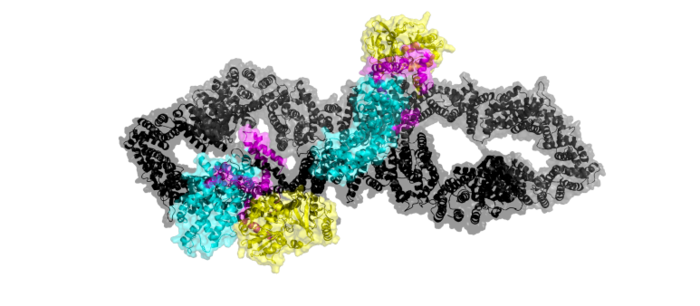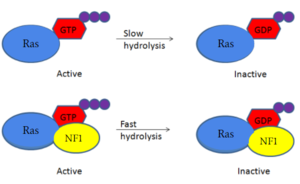Sandbox Reserved 1706
From Proteopedia
(Difference between revisions)
| Line 12: | Line 12: | ||
Neurofibromin is a [https://en.wikipedia.org/wiki/GTPase-activating_protein GTPase-activating protein] that binds to [https://en.wikipedia.org/wiki/Ras_GTPase Ras], a [https://en.wikipedia.org/wiki/GTPase GTPase], to increase its inherent hydrolysis of GTP to GDP (Figure 1). This inactivates the cell signaling of Ras until reactivated by [https://en.wikipedia.org/wiki/Guanosine_triphosphate GTP] exchange. Neurofibromin has two structural conformations, the open and closed conformation. Neurofibromin only binds to Ras in its open conformation. <ref name="Bourne"> DOI:10.1038/39470</ref><ref name="Lupton"> DOI:10.1038/s41594-021-00687-2</ref><ref name="Naschberger"> DOI:10.1038/s41586-021-04024-x</ref> [[Image:RasNeurofibrominMech.PNG|300px|right|thumb|Figure 1: Shifted rate of of Ras GTP hydrolysis when bound to neurofibromin. The speed of GTP hydrolysis is significantly increased when bound to neurofibromin. Ras is inactive when bound to GDP and active when bound to GTP ]] | Neurofibromin is a [https://en.wikipedia.org/wiki/GTPase-activating_protein GTPase-activating protein] that binds to [https://en.wikipedia.org/wiki/Ras_GTPase Ras], a [https://en.wikipedia.org/wiki/GTPase GTPase], to increase its inherent hydrolysis of GTP to GDP (Figure 1). This inactivates the cell signaling of Ras until reactivated by [https://en.wikipedia.org/wiki/Guanosine_triphosphate GTP] exchange. Neurofibromin has two structural conformations, the open and closed conformation. Neurofibromin only binds to Ras in its open conformation. <ref name="Bourne"> DOI:10.1038/39470</ref><ref name="Lupton"> DOI:10.1038/s41594-021-00687-2</ref><ref name="Naschberger"> DOI:10.1038/s41586-021-04024-x</ref> [[Image:RasNeurofibrominMech.PNG|300px|right|thumb|Figure 1: Shifted rate of of Ras GTP hydrolysis when bound to neurofibromin. The speed of GTP hydrolysis is significantly increased when bound to neurofibromin. Ras is inactive when bound to GDP and active when bound to GTP ]] | ||
==Structure== | ==Structure== | ||
| - | Neurofibromin is a [https://en.wikipedia.org/wiki/Protein_dimer protein dimer] that exists in <scene name='90/904311/Closed_conformation/3'>closed</scene> and <scene name='90/904311/Open_conformation/ | + | Neurofibromin is a [https://en.wikipedia.org/wiki/Protein_dimer protein dimer] that exists in <scene name='90/904311/Closed_conformation/3'>closed</scene> and <scene name='90/904311/Open_conformation/14'> open</scene> conformations. The exact initiation of structural rearrangement is currently unknown and a point of further research. DOI:10.1038/39470</ref><ref name="Lupton"> <ref name="Naschberger"> DOI:10.1038/s41586-021-04024-x</ref>. Both protomers contain 5 separate domains, a N-HEAT ARM, C-HEAT ARM, GRD active site, GAPex subdomain, and Sec14-PH domain. |
===Domains=== | ===Domains=== | ||
[[Image:Domain.PNG|500px|right|thumb|Figure 2: Domains for NF1 and the pertinent colors. Numerical values show domain locations along the polypeptide chain.]] | [[Image:Domain.PNG|500px|right|thumb|Figure 2: Domains for NF1 and the pertinent colors. Numerical values show domain locations along the polypeptide chain.]] | ||
| Line 25: | Line 25: | ||
===Conformations=== | ===Conformations=== | ||
====Closed conformation==== | ====Closed conformation==== | ||
| - | Ras is unable to bind to the GRD active site when both of the neurofibromin protomers are in the closed conformation. In the <scene name='90/904311/Closed_conformation/3'>closed conformation</scene>, one protomer has its domains shifted by a 130° rotation of three separate conformational change linkers. That rotation places <scene name='90/904311/Closed_arg/4'>Arg1276 in the closed conformation</scene> in an orientation that <scene name='90/904312/Closed_zoom/1'>sterically hinders the binding between Ras and Arg1276</scene> in the GRD site | + | Ras is unable to bind to the GRD active site when both of the neurofibromin protomers are in the closed conformation. In the <scene name='90/904311/Closed_conformation/3'>closed conformation</scene>, one protomer has its domains shifted by a 130° rotation of three separate conformational change linkers. That rotation places <scene name='90/904311/Closed_arg/4'>Arg1276 in the closed conformation</scene> in an orientation that <scene name='90/904312/Closed_zoom/1'>sterically hinders the binding between Ras and Arg1276</scene> in the GRD site. Ras binding to the GRD site is inhibited by steric occlusion from the N-HEAT ARM. The <scene name='90/904311/Closed_conformation/3'>closed conformation</scene> can exist naturally without any form of stabilization but exists in a natural equilibrium with the <scene name='90/904311/Open_conformation/2'>open conformation</scene>.<ref name="Bourne"> DOI:10.1038/39470</ref> <ref name="Lupton"> DOI:10.1038/s41594-021-00687-2</ref><ref name="Naschberger"> DOI:10.1038/s41586-021-04024-x</ref> |
=====Zinc Stabilized===== | =====Zinc Stabilized===== | ||
The <scene name='90/904311/Closed_conformation/3'>closed conformation</scene> is stabilized by a zinc ion that prevents the shift back to the <scene name='90/904311/Open_conformation/2'>open conformation</scene>. Zinc binding is chelated by three residues (<scene name='90/904311/Zinc_binding_site/5'>Cys1032, His1558, His1576</scene>. These three residues are contributed by the N-HEAT domain (Cys1032) and the GAPex-subdomain (His1558 and His1576). Zinc stabilization keeps Neurofibromin in the <scene name='90/904311/Closed_conformation/3'>closed conformation</scene>, inhibiting Ras binding.<ref name="Bourne"> DOI:10.1038/39470</ref><ref name="Lupton"> DOI:10.1038/s41594-021-00687-2</ref><ref name="Naschberger"> DOI:10.1038/s41586-021-04024-x</ref> | The <scene name='90/904311/Closed_conformation/3'>closed conformation</scene> is stabilized by a zinc ion that prevents the shift back to the <scene name='90/904311/Open_conformation/2'>open conformation</scene>. Zinc binding is chelated by three residues (<scene name='90/904311/Zinc_binding_site/5'>Cys1032, His1558, His1576</scene>. These three residues are contributed by the N-HEAT domain (Cys1032) and the GAPex-subdomain (His1558 and His1576). Zinc stabilization keeps Neurofibromin in the <scene name='90/904311/Closed_conformation/3'>closed conformation</scene>, inhibiting Ras binding.<ref name="Bourne"> DOI:10.1038/39470</ref><ref name="Lupton"> DOI:10.1038/s41594-021-00687-2</ref><ref name="Naschberger"> DOI:10.1038/s41586-021-04024-x</ref> | ||
====Open conformation==== | ====Open conformation==== | ||
| - | In the open | + | In the <scene name='90/904311/Open_conformation/14'> open conformation</scene>, one protomer is shifted to allow Ras binding, while the other protomer remains in the closed conformation. In the <scene name='90/904311/Open_conformation/14'> open conformation</scene> one protomer is rotated 90°, facilitating binding between RAS and <scene name='90/904311/Arg_1276_open/1'>Arg1276</scene> |
| - | In the <scene name='90/904311/Open_conformation/ | + | |
in the GRD site. To allow Ras binding, the GRD and Sec14-PH domains are reoriented away from one another and the GRD site is accessible for Ras binding. This conformational change to the open conformation is driven by rearrangement of three separate linkers (L1, L2, L3).<ref name="Bourne"> DOI:10.1038/39470</ref> <ref name="Lupton"> DOI:10.1038/s41594-021-00687-2</ref><ref name="Naschberger"> DOI:10.1038/s41586-021-04024-x</ref> | in the GRD site. To allow Ras binding, the GRD and Sec14-PH domains are reoriented away from one another and the GRD site is accessible for Ras binding. This conformational change to the open conformation is driven by rearrangement of three separate linkers (L1, L2, L3).<ref name="Bourne"> DOI:10.1038/39470</ref> <ref name="Lupton"> DOI:10.1038/s41594-021-00687-2</ref><ref name="Naschberger"> DOI:10.1038/s41586-021-04024-x</ref> | ||
====Conformational Change Linkers==== | ====Conformational Change Linkers==== | ||
| Line 45: | Line 44: | ||
[https://en.wikipedia.org/wiki/Germline_mutation Germline mutations] are common in NF1 and often cause genetic tumor syndrome through misregulation of the Ras signaling pathway. [https://en.wikipedia.org/wiki/Somatic_mutation Somatic mutations] among NF1 are also extremely common. In germline mutations and some somatic mutations of NF1, tumors develop along the deep epidermis layer of the skin. Understanding how mutations affect the structure and function of neurofibromin will allow for advancements in treatment. | [https://en.wikipedia.org/wiki/Germline_mutation Germline mutations] are common in NF1 and often cause genetic tumor syndrome through misregulation of the Ras signaling pathway. [https://en.wikipedia.org/wiki/Somatic_mutation Somatic mutations] among NF1 are also extremely common. In germline mutations and some somatic mutations of NF1, tumors develop along the deep epidermis layer of the skin. Understanding how mutations affect the structure and function of neurofibromin will allow for advancements in treatment. | ||
DOI:10.3390/cells9112365</ref><ref name="Kioro"> DOI:10.1038/labinvest.2016.142</ref><ref name="Sabatini"> DOI:10.1007/s11940-015-0355-4</ref> | DOI:10.3390/cells9112365</ref><ref name="Kioro"> DOI:10.1038/labinvest.2016.142</ref><ref name="Sabatini"> DOI:10.1007/s11940-015-0355-4</ref> | ||
| + | |||
==FINAL SCENES COPY AND PASTE== | ==FINAL SCENES COPY AND PASTE== | ||
Revision as of 00:45, 19 April 2022
| This Sandbox is Reserved from February 28 through September 1, 2022 for use in the course CH462 Biochemistry II taught by R. Jeremy Johnson at the Butler University, Indianapolis, USA. This reservation includes Sandbox Reserved 1700 through Sandbox Reserved 1729. |
To get started:
More help: Help:Editing |
Neurofibromin 1
| |||||||||||



